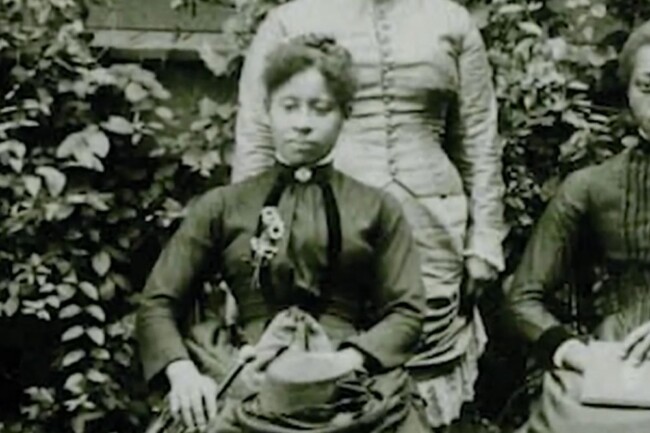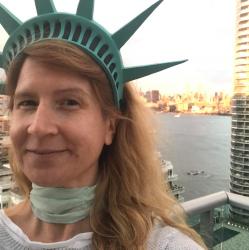Born in 1871 to parents who had been enslaved until the Civil War, Ella Barksdale Brown achieved a Spelman College education before moving to Jersey City. It’s here where she became an avid suffragist, an anti-lynching activist, a journalist for prominent newspapers, and a leader in the development of African American History education. An incredible woman with an inspiring story, read on to learn more about the remarkable life of Jersey City’s Ella Barksdale Brown.
Always Active, Ever Involved
Ella Barksdale was one of the first six graduates of the Atlanta Baptist Female Seminary that later became Spelman College. She married John M Brown in 1898 and the two moved to Jersey City in 1901. John worked for Pullman Company, the railway industry leader known for hiring Black men almost exclusively for their porter positions and paying them a pittance. Ella and John supported the labor union associated with the company, the Brotherhood of Sleeping Car Porters, one of the most powerful African-American political entities of the 20th century.
Read More: The Artist Behind Art World Phenomenon KAWS Hails from Jersey City
Ella clearly felt a responsibility imbued upon her by her education to become a leader for the Black community near and far. She corresponded with the president of Spelman for decades, as she did with countless Black leaders she met throughout her years of activism. Her involvement with the National Association for the Advancement of Colored People (NAACP), the Circle for Negro War Relief, the New Jersey Civil Rights Bureau, and the National Association of Colored Women led to her friendships with such pioneering civil rights leaders as W.E.B. Dubois, Booker T. Washington, Paul Robeson, and James Weldon Johnson. Archive boxes in Yale University’s Beinecke Rare Book and Manuscript Library hold letters of well wishes, sympathy, news, and greetings between Ella and her illustrious peers.
Journalist at Large
Ella reported for important African American newspapers including New York’s Amsterdam News and the Chicago Defender. Both papers were critical in growing the burgeoning movement for civil rights. The Chicago Defender became beloved, as well as targeted, for reportage about and campaigns against Jim Crow-era violence. The paper urged Black residents of the south to move to the north in what became the Great Migration. The Defender’s founder, Robert Abbott, worked out a covert system with Pullman porters, despite the risk of running up against southern state laws, to deliver the contraband paper in the south.
During these early decades of the twentieth century, the Black press was foundational. Black newspapers connected readers to information within their own communities as well as national news that went unmentioned elsewhere. Readers of the Black press would learn about racial violence, about efforts for progress, receive political endorsements, and check the society sections for information about the accomplishments of individuals whose celebrity was recognized here if not within the white press.
Ella also wrote a column for the Jersey Journal for which Journal Square is named. As a columnist in her home city, she furthered health news provided by the American Red Cross and Jersey City Woman’s Club during the global influenza pandemic that reached and devastated Hudson County between 1918-1920. She used her journalism career to advocate for the issues she championed throughout her life: an end to the lynchings that were used to terrorize and control Black people; correction to the discrimination Black WWII war veterans faced upon their return; public awareness of accomplishments by African Americans past and future.
A Righteous Suffragist
As a young woman, Ella was a suffragist, fighting for her vote as an African American and as a woman. She and her peers made crucial contributions to the women’s cause while they also battled racism and discrimination. Her work for women’s suffrage came alongside the broader struggle for basic human and civil rights during the oppressive Jim Crow era. Despite the immense risk that accompanied her activism, she did not hesitate to use her voice to push forward her mission. She was, in fact, the very first woman ever to be appointed to the Hudson County Board of Electors. Resolute in her determination to demand just change she gave speeches entitled “The Negro’s Burden” and “The Negro’s Contribution.”
View this post on Instagram
A Champion of Black History
Ella was invited by the Jersey City Board of Education, amongst other organizations, to speak in their lecture series. Her lectures were titled “Negro Folklore and Music,” “Negro Industry,” and “Negro Education.” She wrote to her correspondents about her belief that education was the key to racial equity. Ella believed that knowing Black history was an essential component of the struggle for equality. A major goal for her, one that she successfully accomplished in 1949, was to have New Jersey designate March 5th as Crispus Attucks day.
Interest in promoting Attucks as a national hero was high when Black veterans returned from war to face racism in their quest for jobs, housing, and education. Black veterans’ heroic participation in World War II presented a new opportunity to invigorate activists in the fight for the full citizenship rights still absent for African Americans. To that end, Ella joined the effort to make the story of Crispus Attucks visible in American public culture and draw mainstream attention to Black history.
See More: A History of Essex County’s Indigenous People
The story of Crispus Attucks served as an historical analog to those of Black WWII heroes. His mother was thought to belong to the Wampanoag tribe. His father was an enslaved African. He, himself, was enslaved 27 years until he liberated himself and went to sea to work as a sailor. On March 5, 1770, Crispus Attucks became a martyr for the American Revolution when he was the first colonist killed by a British soldier in what would be known as the Boston Massacre.
Today, opportunities to celebrate the remarkable life of Ella Barksdale Brown abound. We could recognize her on March 5th, the day she worked to have designated as Crispus Attucks Day or upon her birthday, June 22nd. A plaque could and should be placed at the address where she once lived: 343 Halliday Street. We are, undeniably, indebted to her lifelong work to improve us.











